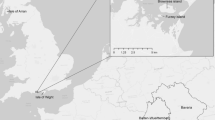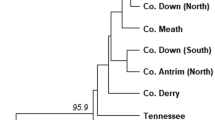Abstract
The Delmarva fox squirrel, Sciurus niger cinereus, is a federally listed endangered subspecies whose range has been reduced by 90%. In an attempt to increase both population size and range, translocation sites were established beginning in the 1960's by moving squirrels from the natural range to sites outside the current range. Although translocations have served as the primary component of the DFS recovery program, there has been very little post-release examination of the genetics of the translocation sites. In this study, we developed ten microsatellite loci, screened the three polymorphic loci, and sequenced a 330 bp fragment of the mitochondrial control region in order to assess levels of genetic variation in natural and translocated regions of Delmarva fox squirrels and to compare them to Southeastern fox squirrels (S. n. niger). Although we found low levels of microsatellite polymorphism, there were no differences in heterozygosity between natural and translocated regions, or between Delmarva and Southeastern fox squirrels. We found high levels of polymorphism in the mitochondrial control region. Our patterns of haplotype diversity suggest incomplete lineage sorting of the two subspecies. In general, our data suggest that the current levels of genetic variation in the translocated sites are representative of those found in the natural population, and we encourage the continued use of translocations as a major component of Delmarva fox squirrel recovery.
Similar content being viewed by others
References
Bailey JW (1946) The Mammals of Virginia. Williams Printing Co, Virginia.
Chakraborty R, Nei M (1976) Bottleneck effects on average heterozygosity and genetic distance with the stepwise mutation model. Evolution 31, 347–356.
Dueser RD, Dooley JL Jr, Taylor GJ (1988) Habitat structure, forest composition, and landscape dimensions as components of habitat suitability for the Delmarva fox squirrel. In: Management of Amphibians, Reptiles, and Small Mammals in North America (eds. Szaro RC, Severson KE, Patton DR), pp. 414–421. U.S. Forest Service Technical Report RM-166.
Dueser RD, Handley CO Jr (1991) Fox squirrel. In: Virginia's Endangered Species (coord. Terwilliger K), pp. 585–589. The McDonald and Woodward Publishing Co., Virginia.
Dueser RD, Terwilliger (1987) Status of the Delmarva fox squirrel (Sciurus niger cinereus) in Virginia. Va. J. Sci., 38, 380–388.
Dunn JP (1989) Translocation of Delmarva Fox Squirrels to Chester County, Pennsylvania. Penn. Game Comm., Harrisburg, PA.
El Mousadik A, Petit RJ (1996) High level of genetic differentiation for allelic richness among populations of the argan tree [Argania spinosa (L.) Skeels] endemic to Morocco. Theor. Appl. Genet., 92, 832–839.
Excoffier L, Smouse PE, Quattro JM (1992) Analysis of molecular variance inferred from metric distance among DNA haplotypes: Application to human mitochondrial DNA restriction data. Genetics, 131, 479–491.
Falk DA, Holsinger KE (eds.) (1991) Genetics and Conservation of Rare Plants. Oxford University Press, New York.
Fies ML (1993) Fox squirrels (Sciurus niger) in Virginia: a review of historical records and information from recent population surveys. In: Proceeding of the Second Symposium on Southeastern Fox Squirrels, Sciurus niger. (eds. Moncrief ND et al.), pp. 37–49. Virginia Museum of Natural History Special Publication No. 1.
Frankham R (1995) Inbreeding and extinction: A threshold effect. Cons. Biol., 9, 792–799.
Frankham R, Ballou JD, Briscoe, DA (2002) Introduction to Conservation Genetics Cambridge University Press, Cambridge, UK.
Goudet J (2001) FSTAT, a Program to Estimate and Test Gene Diversities and Fixation Indices (version 2.9.3). Available from http://www.unil.ch/izea/softwares/fstat.html. Updated from Goudet (1995).
Hamilton MB, Pincus EL, DiFiore A, Fleischer R (1999) Universal linker and ligation procedures for construction of genomic DNA libraries enriched for microsatellites. BioTechniques, 27, 500–507.
Handley CO Jr, Patton CP (1947) Wild Mammals of Virginia. Virginia Comm. of Game and Inland Fisheries, Richmond.
Ingles LG (1965) Mammals of the Pacific States. Stanford University Press, Stanford, CA.
Kammermeyer K (1994) Managing for peach state squirrels? Georgia Dept. of Nat. Res.
Kocher TD, Thomas WK, Edwards A et al. (1989) Dynamics of mitochondrial DNA evolution in animals: Amplification and sequencing with conserved primers. Proc. Nat. Sci., 86, 6196–6200.
Loeb SC, Moncrief ND. (1993) The biology of fox squirrels (Sciurus niger) in the Southeast: A review. In: Proc. Second Symposium on Southeastern Fox Squirrels, Sciurus niger. Aug. 11-12, 1992. Clemson, SC (eds. ND Moncrief, Edwards JW, and Tappe PA), pp 1–19. Virginia Mus. Nat. Hist., Special Pub. 1, VA.
Linzey DW (1998) The Mammals of Virginia. The McDonald and Woodward Publishing Co., Virginia.
Lustig LW, Flyger V (1975) Observations and suggested management practices for the endangered Delmarva fox squirrel, Sciurus niger. Proc. Conf. of the Southeastern Assoc. of Game and Fish Commissioners, 29, 433–440.
Mansueti R (1948) Comments on the fox squirrels of Maryland. Maryland Naturalist 22, 30–41.
Maryland Forest, Park and Wildlife Service (1989) White Paper, Technical Planning, Document #1, Planning and Program Development.
Moncrief ND (1993) Geographic variation in fox squirrels (Sciurus niger) and gray squirrels (Sciurus carolinensis) of the lower Mississippi river valley. J. Mammal., 74, 547–576.
Moncrief, ND and Dueser RD (2001) Allozymic variation in the endangered Delmarva fox squirrels (Sciurus niger cinereus): Genetics of a translocated population. Am. Midl. Nat., 146, 37–42.
Nei M, Maruyama T, Chakraborty R (1975) The bottleneck effect and genetic variability in populations. Evolution, 29, 1–10.
Nei M (1987) Molecular Evolutionary Genetics. Columbia University Press, New York.
Poole EL (1932) A survey of the mammals of Berks County, Pennsylvania. Reading Public Museum and Art Gallery Bull. No. 13. Reading, Pennsylvania.
Reynolds KM (1988) Reintroduction of the Delmarva fox squirrel in Delaware. Delaware Division of Fish and Wildlife, Job Progress Report, PR Project W-16-R.
Rohlf FJ (1973) Algorithm 76. Hierarchical clustering using the minimum spanning tree. The Computer Journal 16, 93–95.
Schneider S, Roessli D, Excoffier L (2000) ARLEQUIN ver 2.000. A software for population genetics data analysis.
Snyder NFR, Derrickson SR, Beissinger SR et al. (1996) Limitations of captive breeding in endangered species recovery. Cons. Biol., 10, 338–348.
Taylor GJ (1973) Present status and habitat survey of the Delmarva fox squirrel (Sciurus niger cinereus) with a discussion of reasons for its decline Proc. Annu. Conf. Southeast. Assoc. Game and Fish Comm., 27, 278–289.
Therres GD, Willey GW (in press) Reintroductions of the endangered Delmarva fox squirrel in Maryland. Proc. Annu. Conf. Southeast. Fish and Wildl. Agencies.
U.S. Fish and Wildlife Service (1993) Delmarva Fox Squirrel (Sciurus niger cinereus) Recovery Plan, Second Revision. Hadley, Massachusetts. 104 pp.
Weir BS, CC Cockheram (1984) Estimating F-statistics for the analysis of population structure. Evolution, 38, 1358–1370.
Wood GW, JR Davis (1981) A survey of the perception of fox squirrel populations in South Carolina. Clemson Univ. Forestry Bullet., 46, 9 pp.
Wright S (1931) Evolution in Mendelian populations. Genetics, 16, 97–159.
Author information
Authors and Affiliations
Corresponding author
Rights and permissions
About this article
Cite this article
Lance, S.L., Maldonado, J.E., Bocetti, C.I. et al. Genetic variation in natural and translocated populations of the endangered Delmarva fox squirrel (Sciurus niger cinereus). Conservation Genetics 4, 707–718 (2003). https://doi.org/10.1023/B:COGE.0000006112.18846.9f
Issue Date:
DOI: https://doi.org/10.1023/B:COGE.0000006112.18846.9f




